| �����{�ꑢ�D�������w���� �ŐV���Ɩ����̃h�b�N |
||||
|---|---|---|---|---|
| Visiting the Former Yokosuka Shipyard The latest aircraft carrier and the dock at the end of the Edo period |
||||
| ���{�̎Y�Ɗv���̒n�E���{�� �]���A���{�̍H�Ƃ̌����͂͐l�́E���n�E���Ԃ܂ł������B���{�ꐻ�S���͂͂��߂�����C�@�ւ������͂Ƃ��Ă�������u���C�@�ւ������͂Ƃ�����{�ŏ��̑����H��v�Ƃ�����B�܂��ɓ��{�̎Y�Ɗv���̒n�ł���B�i�n�ɑ��Y���u���{�̋ߑ�H�w�̂��������̌���v�i�u�O�Y�����L�v�j�Ə������̂́A���̂��Ƃ��w���B |
||||
| Yokosuka, the Site of Japan's Industrial Revolution In the past, the driving force of Japanese industry was human power, cattle and horses, and even water wheels. However, the Yokosuka Ironworks was powered by steam engines from the beginning, making it "Japan's first integrated plant powered by steam engines." It is truly the site of Japan's industrial revolution. This is what Ryotaro Shiba meant when he wrote that the Yokosuka Ironworks was "the source of all modern engineering in Japan" in his book of "Miura Peninsula Chronicles." |
||||
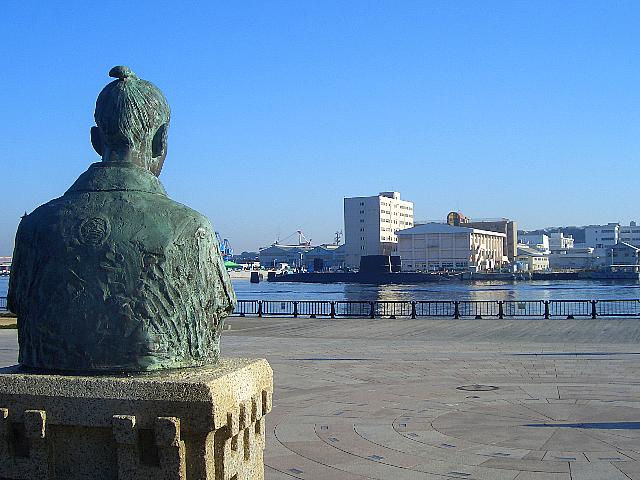 |
||||
| �����{�ꑢ�D�������߂鏬�I�������@�@�i�q���{��w�O�E���F���j�[���� �����F���j�[�����̒��ԏ��@�R�`���@�@�����U��E���I����ƃ��F���j�[�����E���F���j�[�L�O�فE�e�B�{�f�B�G�@���w���֗��ɂȂ�܂����B�@��^�o�X�\��\���p���̓R�`������ ���i���R�[�X�ɂ����ӁI����16���u���{��X���v�����(���{��w���ʂ���j��������Ȃ��B |
||||
| �� Kozukenosuke Oguri gazing at the former Yokosuka Shipyard Verny Park, in front of JR Yokosuka Station ��Parking lot of Verny Park �� Click here It is now convenient to stroll in the park, visit the busts of Kozukenosuke Oguri and Francois Leonce Verny, and the Verny Memorial Hall.�@ (Note) Please be careful of the entry course! You can only enter the park from the outbound line of Route 16 "Yokosuka Kaido." |
||||
���w�E2014����24�N6��4�� ��2014����26�N6��4�� ���Q�n�������� �x�������ꂪ�܂��Ȃ����E��Y�ɔF�肳��邩�A�Ƃ������Ƃł��̌��ɂȂ��Ă���͉̂��{�ꐻ�S���ł��邱�Ƃ����悳�ꂽ�c�A�[�B���I����[�t�����X�l�Z�t���t�����\���E���I���X�E���F���j�[�\���{�ꑢ�D���\�x��������̂Ȃ�����Ċm�F�B �@�@�@�@�@�@ 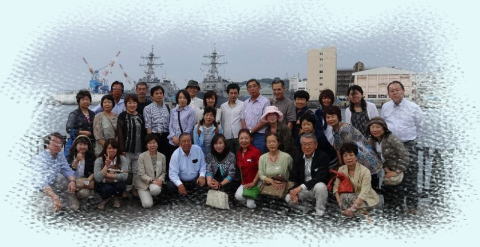 |
||||
| �@�@�@�@�@�@�@�@Visited on June 4, 2014 �� June 4, 2014 �� Gunma Franco-Japonais Society This tour was planned because the Tomioka Silk Mill will soon be recognized as a World Heritage Site, and the Yokosuka Ironworks is the source of that recognition. We reconfirmed the connection between Kozukenosuke Oguri - French Chief Engineer Francois-Leonce Verny - Yokosuka Shipyard - Tomioka Silk Mill. |
||||
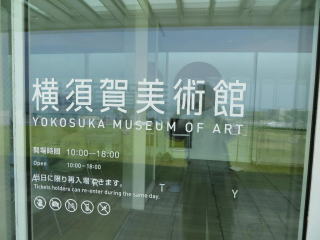 |
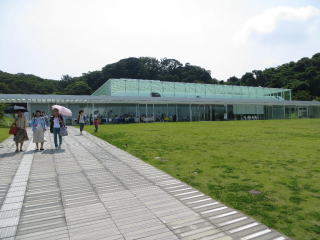 |
|||
| ���͂��߂Ɋω���̉��{����p�قɓ����Ē��H�̂��ƃA�[���E�f�R�ӏ܁B�u��������������ˁA���̂��������B�Ȃ�Č����������c�v�u���O�Ȃ�Ăǂ��ł������̂�`�A�����������A�L���n�n�v | ||||
| �� First, we went to the Yokosuka Art Museum in Kannonzaki for lunch and to see the art deco works. "What was the name of that fish dish?" "I don't care what it's called, as long as it's delicious." | ||||
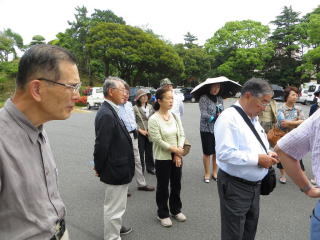 |
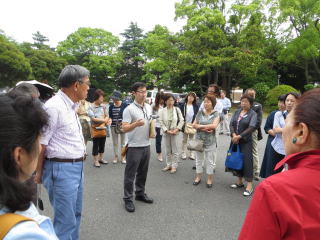 |
|||
| �����\���Ċ�n�L�E������ĊC�R��7�͑��i�ߕ��Ɖ��{���n�i�ߕ��O�Ő�������B | ||||
| �� We received a briefing from a staff member of the base's Public Affairs Department in front of the U.S. Navy's 7th Fleet Headquarters and Yokosuka Base Headquarters. | ||||
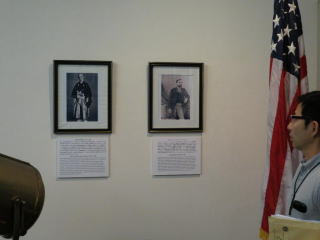 |
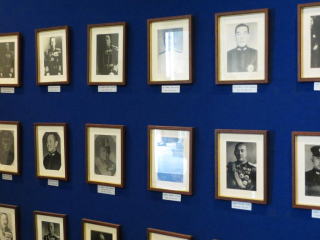 |
|||
| ����n�i�ߕ��̌��փz�[���ɏ��I����ƃ��F���j�[�̎ʐ^���f������Ă���̂ɋ����B�����̋ߑ㉻�̓w�͂������č��̊�n������A�Ƃ������Ƃ������Ă���B | ||||
| �� We were surprised to see a picture of Kozukenosuke Oguri and Verny displayed in the entrance hall of the base headquarters. It shows that the modernization efforts at the end of the Tokugawa Shogunate led to the base we know today. | ||||
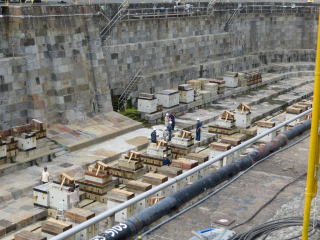 |
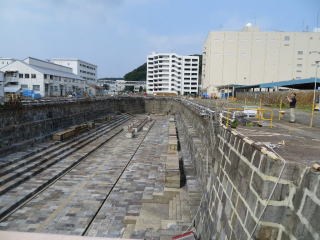 |
|||
| �����F��2�h�b�N�ɂ܂��Ȃ��C���̑D������Ƃ������ƂŁA�D�̐v�}�ʂɏ]���Ď��̃Z�b�e�B���O��Ƃ��s���Ă����B���̍�Ƃ�����̂͏��߂Ă��B�@�@ �E�F�����̌c��3�N�Ɍ@��n�߂āA����4�N�Ɋ���������1�h�b�N�B |
||||
| �� Left: A ship was soon to enter the second dock for repairs, and the receiver was being set up according to the ship's design drawings. This was the first time I saw the work. Right: The first dock, which began digging in 1867 (Keio 3) at the end of the Edo period and was completed in 1871 (Meiji 4). |
||||
| �@���w�E2011����23�N10��27���@ ��2011����23�N10��27�� �������|�V��L�u �����s�Ńl�W�Ȃǂ̓S�|���i�삵�Ă��钩���|�V��̃����o�[�ƂƂ��Ɍ��w�B���I�������A�����J���玝���A�����l�W�B��m���ē��P���ɎQ�q������A����ǂ͉��{��ցA�Ƃ������ƂŊ�悳�ꂽ���́B���{��w�O�ɏW�����A�s���ی𗬉ۂƊό��ۂ���p���t���b�g���������������ƁA���F���j�[�����ŏ��I�E���F���j�[�̋����⃔�F���j�[�L�O�ق����w�̂��Ɗ�n�ɓ���A�h�b�N��i�ߕ��Ȃǂ����w�B |
||||
| Visited on October 27, 2011 �� October 27, 2011 �� Volunteers from Asaka Koyukai Members of the Asaka Koyukai, a group that manufactures screws and other steel products in Asaka City, Saitama Prefecture, and I visited Yokosuka. Asaka Koyukai people learned about the screw nails that Tadamasa Oguri brought back from the U.S. and, after visiting Tozenji Temple, they decided to go to Yokosuka. We gathered in front of Yokosuka Station, and after receiving brochures from the city's International Exchange Division and Tourism Division, we visited the busts of Oguri and Verny and the Verny Memorial Hall in Verny Park, and then entered the base to see the docks and the command center. |
||||
 |
 |
|||
| �����F���j�[�����̋����Ɉ��A����B�@�@�@�@�@�@�@�@�@�@�@�@�@�@����n�̕ĊC�R�i�ߕ� | ||||
| ��Left: Greeting the bust in Verny Park.Right: U.S. Navy Headquarters at the base | ||||
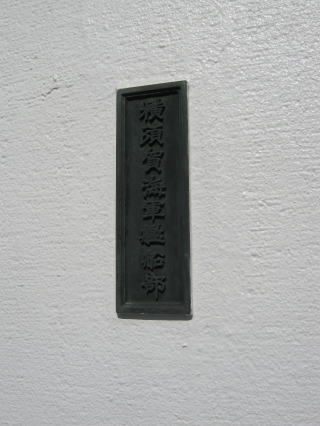 |
 |
|||
| ���u���{�����{�v�̃v���[�g�����ւɂ͂ߍ��܂ꂽ�܂ܕۑ�����Ă���B���r�[�ɓ���Ə��I����ƃ��F���j�[�̎ʐ^���ǂɌf������Ă���B | ||||
| ��Left: The "Yokosuka Chinjufu" plaque is still in place, inset in
the entrance. Right: Photos of Kozukenosuke Oguri and Verny are displayed on the wall in the lobby. |
||||
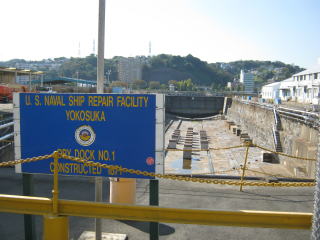 |
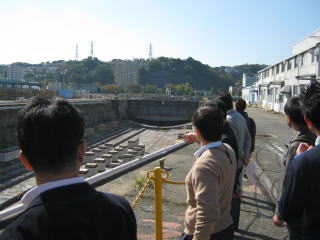 |
|||
| �������Ɍ@��͂��߁A����4�N�Ɋ���������1�h�b�N�͍��ł������Ŏg���Ă���B ���q�͋��u�W���[�W���V���g���v�͌��݂ǂ����֏o�����ŁA���̊͑D���C�����ł����͌��w�͏o���Ȃ������B |
||||
| ��The first dock, dug at the end of the Edo period and completed in 1871
(Meiji 4), is still in use today. The nuclear-powered aircraft carrier "George Washington" is currently on deployment somewhere, and other ships are also undergoing repairs, so we were unable to board a ship for a tour. |
||||
| �@�@�@���w�E2010����22�N3�� ����s�Q�n�n�斯���ψ��E�����ψ���̉���L�u�ɂ�鏬�I����j�Ռ��w��A���ݕĊC�R���{���n�ƂȂ��Ă��鉡�{�ꑢ�D���Ւn�ɓ���܂����B ���Q�O�P�O�����Q�Q�N�R���P�U�� �����{�ꑢ�D���Ւn�̃h�b�N���w�\���H�\���W���[�W�E���V���g�����w�\���F���j�[�L�O�ٌ��w�\���I����E���F���j�[�����w |
||||
| Visited on March 2010 A field trip group of Kozukenosuke Oguri historical sites by voluntary members of the Takasaki-Gunma Area Welfare Committee and Children's Committee entered the site of the Yokosuka Shipyard, which is now the U.S. Navy's Yokosuka Base. �� March 16, 2010 �� Visit to the dock at the Yokosuka Shipyard site - Lunch - Visit to the aircraft carrier George Washington - Visit to the Verny Memorial Museum - Visit to the statue of Kozukenosuke Oguri and Verny |
||||
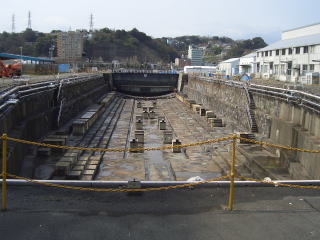 |
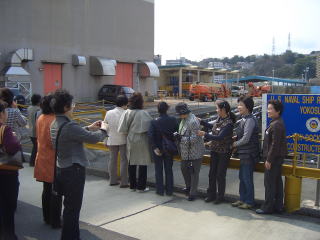 |
|||
| ��P���h�b�N �܂������c���R�N����@���ĂS�N�������Ė����S�N�Ɋ��������Α��̂P���h�b�N�����w�B�����{�A�_���v�A�u���h�[�U�̂Ȃ�����Ɏ�Ō@���āA�����œy���o������J�ɁA�����̐����オ��B�u���A�[�A����������l�G�`�v����B�̏������t�B |
||||
| No. 1 Dock: First, we visited the first dock made of stone, which was dug from the end of the Edo period in 1867 (Keio 3) and completed in 1871 (Meiji 4) after four years of work. We shouted in admiration as we learned of the hard work that went into digging and carrying the soil out by hand in the days when there were no hydraulic shovels, dump trucks, or bulldozers. |
||||
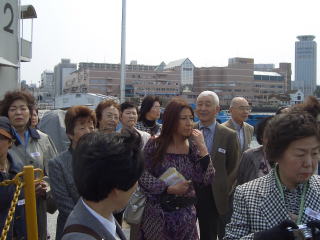 |
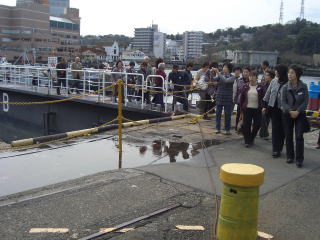 |
|||
| �h�b�N�̂ӂ��̏�ŁA�u���̂ӂ��i���j�̒��͋ɐ�������܂��B�܂������Čy�����A�D�ʼng���Ăǂ����ƁA�C������D����������A�܂����������Ă��Đ��𒍓�����ƒ���ň��肵�܂��c�v�Ɛ�������B������̂��D���ƂɈقȂ�ʒu�Ɏ����Z�b�g���āA�Ȃ��Ȃ���ρB�����I���ƁA�h�b�N���̐����đD��܂ŏC�����A�C�����I���Ƃ܂����̋t�̕��@�Ńh�b�N����D���o���܂��B | ||||
| On top of the dock lid, the local guide explained, "Inside this lid (door) is a cavity filled with water. First, the water is drained out to make it lighter, and then it is towed away by a boat, and then the boat to be repaired is pulled in, and then the door is pulled back in and water is injected to make it sink and stabilize it. It was quite a task to set the bogies in different positions for each ship. After setting, the water in the dock is drained and the bottom of the ship is repaired, and after the repairs are completed, the ship is taken out of the dock in the opposite way. | ||||
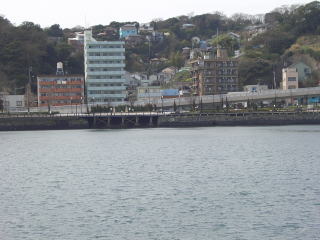 |
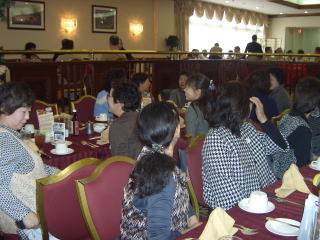 |
|||
| �Ί݂̔����r���̉��ɏ��I����ƃ��F���j�[�̋����������܂��B | ���H�͏��Z�p�̃��X�g�����ŁA�����X�e�[�L�B�傫�����Ă��Ă��܂��l�������悤�Łc�B ���́u�����Ȃ�ċv���Ԃ�c�v |
|||
| Left: The busts of Kozukenosuke Oguri and Verny can be seen under the white
building on the other side of the river. |
Right: Lunch was a thick steak at a restaurant for officers. The steaks were so big that some people were overwhelmed. I said to myself, "I haven't had meat in a long time..." | |||
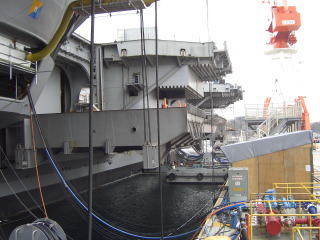 |
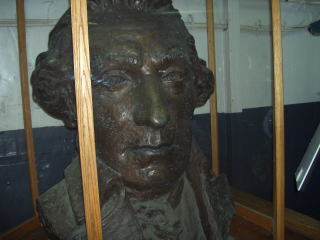 |
|||
| ���W���[�W���V���g�� �S���R�T�Wm�A���W�Q���ƕ����Ă��s���Ƃ��Ȃ��B���Ԃ̃^�i�͔�s�b�ɉ��肽��s�@�����̊i�[�ɂɉ��낷�G���x�[�^�[�A�ƕ����Ƌ����B�l�ԂȂ�Q�O�O�l����B |
�W���[�W�E���V���g���� �������D�̖��̂䂩��̐l���̑����i�[�ɂɐݒu���āA�uSPRIT OF FREEDAM�v��W�Ԃ��Ă��܂��B ��g�����U�Q�T�O���A����̐H��18,000�H�̑����97,000�g���B�����Ⴂ�̑傫���I |
|||
| Left: Aircraft Carrier George Washington When we heard that it is 358 meters long and 82 meters wide, it didn't ring a bell. I was surprising to hear that the middle shelf was an elevator that lowers the plane down to the flight deck and into the hangar below. It can hold 200 people. |
Right: Statue of George Washington As expected, a statue of the person associated with the name of the ship is placed in the hangar, advocating the "SPRIT OF FREEDAM." With a crew of 6,250 and 18,000 meals a day, the carrier is 97,000 tons. That's a heck of a lot of size! |
|||
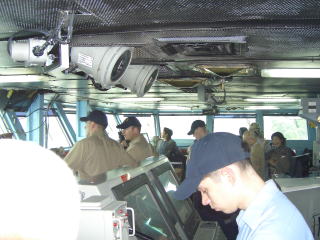 |
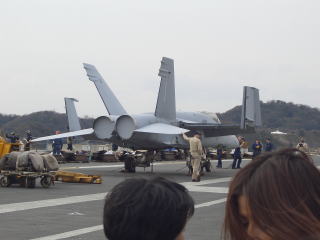 |
|||
| �i�ߓ��̎w�ߎ� ����͎i�ߎ��܂ňē����Ă���܂����B�͒��̃C�X�ɂ����点�Ă�����ăS�L�Q�� |
��s�b�ł͖͋[�퓬�@��u���āA��~�̌P�������Ă��܂��B | |||
| Left: The command center in the control tower This time, they showed us to the command center. We were even allowed to sit in the captain's chair. |
Right: On the flight deck, a mock fighter is being trained to stop. | |||
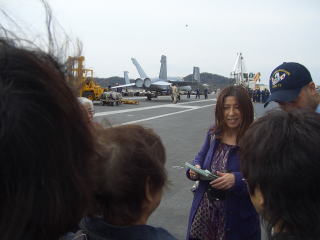 |
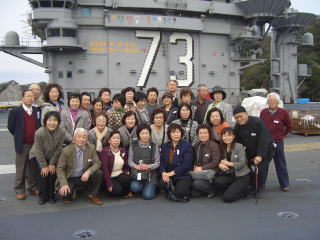 |
|||
| �┑���Ă��鎞���ɂł͂Ȃ��A�Ƃ��������Ƀi�b�g�N�B | �i�ߓ��̑O�ŋL�O�B�e�B���{�͕��a���Ȃ��B | |||
| When we were told that the ship was not idle even when it was at anchor, we understood. | We took a commemorative photo in front of the control tower. Japan is so peaceful. | |||
| �@�@�@�@���w�E200�X����2�P�N2�� �O�N�H����n�܂���������w�����فu���I����u���v��u����ΏۂƂ����A�����{�ꑢ�D���̎j�Ռ��w�c�A�[���A���I����̎j�Ղ������i���P���j��Âōs���܂����B ��2009����21�N2��12�� ���R�[�X�@���F���j�[�L�O�ف`���F���j�[�����`�ĊC�R���{���n�i���W���[�W���V���g���E�h���C�h�b�N�E������{�i�ߕ��j�`�O�}�����`�s���R�l�������� �����̌��w�����{���n�̐V���u�r�d�`�g�`�v�j�E�C��v���g�b�v�ŕ���܂����B |
||||
| �@�@�@�@�@�@Visited on February 2009 A tour of the historical sites of the former Yokosuka Shipyard for students of the "Kozukenosuke Oguri Lecture" at the Meiji University Museum was organized by the Society for visiting Kozukenosuke Oguri's Historic Sites (Tozenji). The tour of historical sites started the previous autumn. �� February 12, 2009 �� Course: Verny Memorial Museum - Verny Park - U.S. Naval Base Yokosuka (Aircraft Carrier George Washington Drydock, former headquarters of the township) - Mikasa Park - City Museum of Nature and Humanity �� This tour was reported on the top page of SEAHAWK, the newspaper of Yokosuka Air Base. |
||||
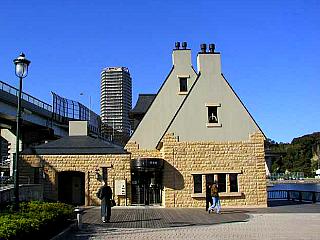 |
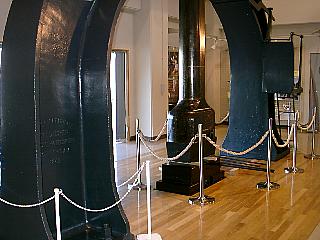 |
|||
| ���F���j�[�L�O���@�t�����X�Z�t�����F���j�[�̖����������L�O�قɏW���B�����ɂ́A����9�N�܂ʼnғ����Ă����X�`�[���n���}�[���ۑ�����Ă���B�I�����_�E���b�e���_�����A�n���}�[�d��3�d�A���C�̗͂Ŏ����グ�đ��ɒu�����Ă����S�ނ�b������B�u�}�U�[�}�V���v | ||||
| Verny Memorial Hall:We gathered at the memorial hall named after the French Chief Engineer Francois Leonce Verny. Here, the steam hammer that was in operation until 1997 is preserved. The hammer was made in Rotterdam, the Netherlands, and weighed 3 tons. It used steam power to lift and forge burnt iron on the table. Link to the Mother Machine | ||||
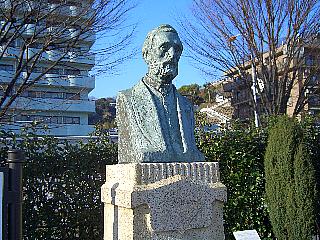 |
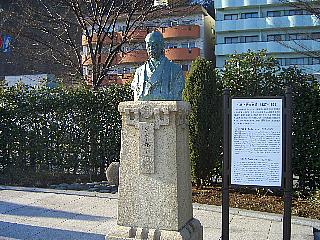 |
|||
| ���F���j�[�����@�����̒����A���̌��Ƀ��F���j�[�Ə��I����̋����������яオ��B�����̔w��ɂ́A���a28�N�ɑq����������ꂽ���I���Ŋ��̒n�����͌��̐���A���ꂢ�ɕ��ׂ��Ă���B | ||||
| Verny Park:In the center of the park, the busts of Verny and Kozukenosuke Oguri float in the morning light. Behind the busts, river stones from the Mizunuma Riverbank, the final resting place of Oguri, donated by Kurabuchi Village in 1953, are neatly arranged. | ||||
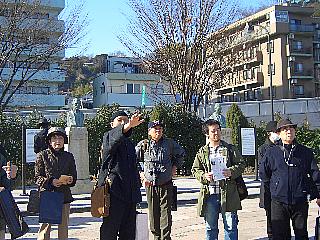 |
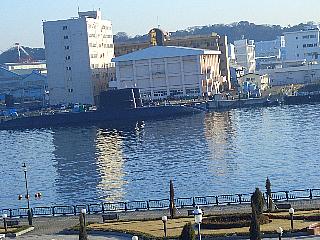 |
|||
| �h�b�N��]���@�����̑Ί݂������`�����Ɍ@��ꂽ�h�b�N�B�u���̐����͂̉E�肪��3�h�b�N�A���̉E����2�ŁA����ɑ�1�h�b�N���c�v�ƊT�ς�����ł���o�X�ŕĊC�R���{���n�֓��\����B�����͐����͂�2�ǂ������Ă���B | ||||
| View of the docks:On the other side of the park are the docks that were dug in the late Edo and Meiji periods. To the right of the submarine is the third dock, to the right of that is the second dock, and then the first dock..." After getting an overview, we took a bus to the U.S. Navy Yokosuka Station. There were two submarines in the base today. | ||||
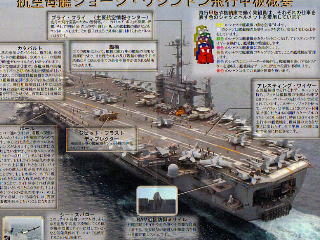 |
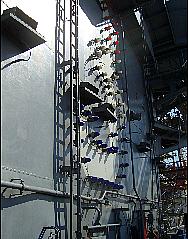 |
|||
| ���̃p���t���b�g���@����͋��W���[�W���V���g���̌��w������ꂽ�B���w�p�Ƀp���t���b�g���p�ӂ���Ă��āA�T�v�����߂�B�p���t�̒����A�͋����́u73�v�Ƃ��������̂R�̉����E�̎ʐ^�ƂȂ�B | ||||
| �� Aircraft Carrier Brochure: This time we got permission to visit the aircraft carrier George Washington. A brochure was prepared for the tour to give us an overview. In the center of the brochure, below the number 3 on the bridge, is the photo on the right. | ||||
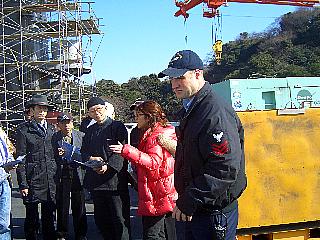 |
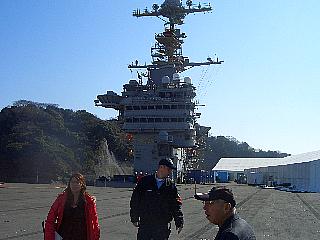 |
|||
| ��s�b���@���H�̂悤�ȋ����K�i��������オ���āA�o�Ă����Ƃ���͔�s�b�B���ׂ͍��Ȃ����g�̂悤�ɂȂ��ăX���b�v�~�߂ƂȂ��Ă���B�e���g�͂��ܕ�C��ƒ��̍�Ə����ŁA��������ׂčb�̏�B�퓬�@�͏��}�b�`�����炢�Ɍ����邱�̍b�߂����ĕ����~��A���s������u�^�b�`�A���h�S�[�v�ōĂѕ����オ�邽�ߍő呬�x�Œ��͂���B�����H���~�߂鑾�����C���[�������ɂ������B�����S�����낤�Ǝv���Ă����͍̂��o�ŁA���S�Ƀ��C���[�B | ||||
| On the flight deck:�@�@After climbing a maze of narrow stairs, we came out on the flight deck. The floor is made of fine ripples to prevent slipping. The tents were work sheds undergoing repairs, all on the deck. Fighter planes soar down to this deck, which looks like a matchbox from above, and they touch down at maximum speed to soar up again if they fail. There was a wire at my feet to stop them. I thought it would be thick rubber, but I was wrong and it was completely wire. | ||||
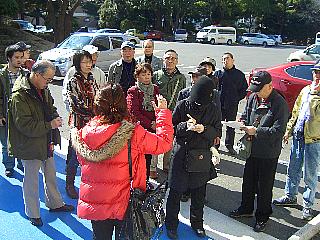 |
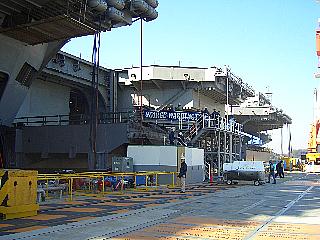 |
|||
| ��g������6000�l�A�f��ق������B�E�ʐ^�̍b����Ă���Ƃ������͔�s�@�����̊K�Ɋi�[���邽�߂̃G���x�[�^�[�ŁA���E�Ɍv4�䂠��A���܂����͉���Ă����ԁA�Ƃ������ƁB��s�@�͉��{��֓���O�ɗ����n�ֈړ����āA�D�����œ����Ă���Ƃ����B�d�b�̐�2000��A����̔z�H��18000�H�A�d��30�g���̕d���v2��c���������тɁA�ց[�b�Ƌ����̐����o��B | ||||
| There are about 6,000 crew members on board, and two movie theaters. In the photo on the right, where the deck is cut off (��) are elevators for storing airplanes on the lower floors, and there are four in total on both sides. In this photo, the elevators are in the down position. The planes are said to be moved to the Tachikawa base before entering Yokosuka, and only the ship comes in. There are 2,000 telephones, 18,000 meals a day, and two anchors weighing 30 tons... Every time we hear the explanation, we are amazed. | ||||
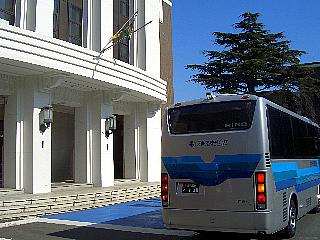 |
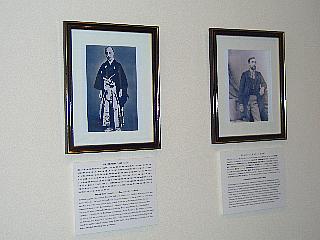 |
|||
| ������{�@�@�@���C�R����{�̌����͕ĊC�R�ɓ���n�ƁA���{���n�̎i�ߕ��ƂȂ��Ă���B���փ��r�[�ɂ͋ߔN���I����ƃ��F���j�[�̎ʐ^�������āA�ĊC�R��n�̏������悤�₭���������{�ߑ㉻�̑厖�ȏꏊ���������Ƃ�F�����n�߂����Ƃ��B | ||||
| Former Naval Base: The building of the former naval base is now the headquarters of the U.S. Naval Far East Base and the Yokosuka Base. In recent years, photographs of Kozukenosuke Oguri and Verny have been displayed in the entrance lobby, indicating that the officers of the U.S. Naval base are finally beginning to realize that this was an important place for the modernization of Japan. | ||||
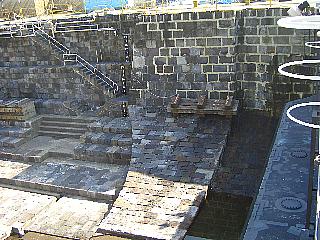 |
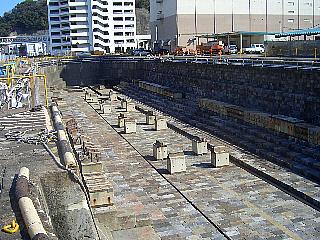 |
|||
| �h�b�N�@�c��3�N�i1867�j�Ɍ@��n�߂Ė���4�N�Ɋ���������1���h�b�N�͌��݁B�ؐΐς݂̕ǂ����j���B ���{�ꐻ�S���c���D���͏��ߖ���4�N�܂ʼn��{�ꐻ�S���Ƃ������̂ł������B���������݂̈Ӗ��̐��S�͂��Ȃ��A�u�S���i���鏊�v�Ƃ����Ӗ��B����4�N�Ȍ�Ɂu���S���v�̈Ӗ����ς���āA�u�S�z����S���鏊�v�Ӗ��ɂȂ����B |
||||
| Left: Dock�@The first dock, which began digging in 1867 and was completed in 1871,
is still standing. The masonry walls tell the story of its history. Right: Yokosuka Ironworks�@�@The shipyard was first called Yokosuka Ironworks until 1871. At the time, however, it did not produce iron in the current sense. It meant only "a place to make iron products." The meaning of "ironworks" changed after the Meiji era, and it came to mean a place where iron was produced from iron ore. |
||||
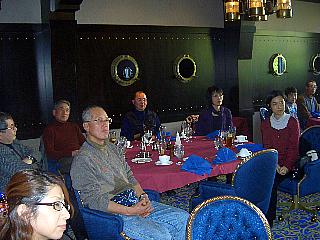 |
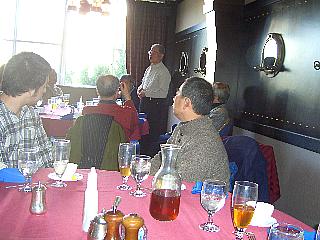 |
|||
| ���H�@��n���̃��X�g�����ŃX�e�[�L�̒��H�B����ȂɌ����X�e�[�L�͂߂����ɂ��ڂɂ�����Ȃ��A�ƂԂ₭�B | �@���ȏЉ��@�@���H�̌�A�Q���҂̎��ȏЉ�Ɗ��z�B���I����u���Ŋ�Ȃ��݂ɂȂ��Ă��Ă����O�܂ł͒m��Ȃ����m�������̂ŁA����őł��Ƃ������͋C�ɂȂ����B | |||
| Left: Lunch Time:�@We had a steak lunch at a restaurant on the base. We commented that it
was rare to see such thick steaks. �@ |
Right: Self-introductions�@�@After lunch, the participants introduced themselves and gave their impressions. Although we were familiar with each other from the Kozukenosuke Oguri lecture, we didn't know each other's names, so this gave us a chance to get to know each other better. | |||
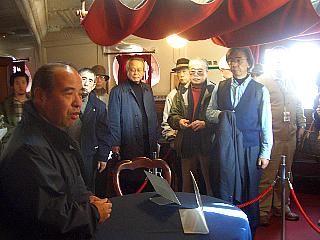 |
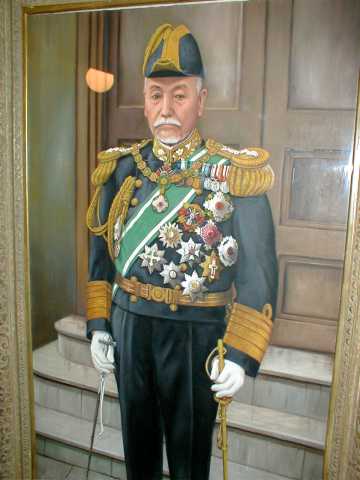 |
|||
| �O�}�@�R�͎O�}�͐��̍r�p����ۑ��^���ɂ���ēW���قƂȂ��Ă���B�u���{�C�C��̏����͏��I����̑��������{�ꑢ�D���̂������v���⑰�ɗ�����������������Y�̑傫�ȊG�������Ă���B���V�A�͑����o���g�C�̃��o�E����͂��ɓ����{�܂ł��ǂ�������Ƃ��킩��G�}���A��ۓI�B | ||||
| Mikasa �@�@The warship Mikasa has been turned into an exhibition hall by the preservation movement since it fell into disrepair after the war. A large painting of Heihachiro Togo, who thanked the bereaved family of Kozukenosuke Oguri saying, "The victory in the Battle of the Sea of Japan was thanks to the Yokosuka shipyard built by Mr. Oguri," is on display. The picture of the Russian fleet coming all the way from Libau in the Baltic Sea to the Far East is impressive. | ||||
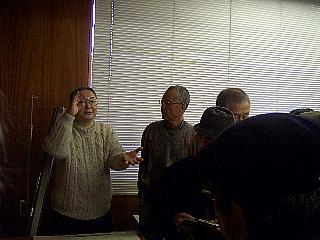 |
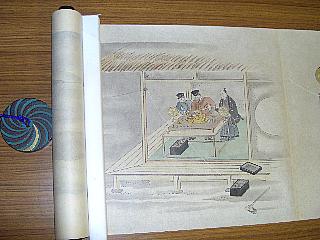 |
|||
| �s���R�l���������@�@�[�c��ɂ��锎���قŊw�|�����r�q�K����̉���̂��ƁA���ʂɃy���[�̂��y�Y�̓d�M������l�Ŏ��ۂɎ������Ă���G���������Ă����������B���̊G���A���y�Y��I�̂�����̊G�ƂȂ���B | ||||
| Yokosuka City Museum of Nature and Humanities After an explanation by curator Hiroyuki Yasuike at the museum in Fukatadai, we were shown a special picture scroll of an actual experiment with telegraph equipment in Yokohama. This telegraph was brought from the U.S. by Matthew Calbraith Perry as a souvenir. This picture is related to the other picture of showing the souvenir. |
||||
| �uSEAHAWK�v�i�C���j�c�ĊC�R���{���n�V���E2009����21�N2��27���� �g�b�v�ɂ��̌��w�̋L�����ڂ�܂����B �ĊC�R���{���n�V���@�Q�O�O�X�D�Q�D�Q�V�@�L�� �@�@�@�@�@�@�@�@�@�@�@�@�@�@�@�@�@�@�@�@�@�@�@�@�@�@�@�@�@�x���E�A���B�[�L�ҁi�b�e�`�x�L�j |
||||
| "SEAHAWK"...U.S. Navy Yokosuka Base Newspaper, February 27, 2009 The article about this tour was on the top page. U.S. Navy Yokosuka Base Newspaper, 2009.2.27 Article by Ben Avey, CFAY Public Affairs |
||||
| �@�@�@�u�r�d�`�g�`�v�j�E�C��v�@ �@�@�@���{�l�w���A�b�e�`�x�c�A�[�� ���{��̗��j���w�� "SEAHAWK" Japanese Students on FAY Tour Learning the History of Yokosuka |
||||
| �@�Q���P�Q���A�����̖�����w������{�l�w�����������{��͑��i�ߕ��i�b�e�`�x�j��K��A���{�ꏉ���̑��D���̋N���Ƃ��̑n���ҏ��I����ɂ��Ċw�т�[�߂��B �@���I�͂P�W�O�O�N�㒆����ɓ��얋�{�̍�����b�i�����s�j�߁A���{�̉��{��ɑ�K�͂ȑ��D���ƍ`�邱�Ƃ����肷��ɍۂ��đ傫�ȉe���͂��������l���ł���B�ނ��Ȃ������Ƃ̉e���͍��Ȃ��������Ă��邽�߁A�Q�T�l�قǂ̓��{�l�̊w�������͏��I�̐��U�ƈ�Y�S�̂ɏœ_�Ă�����u������u���邱�Ƃ��ł����B �@�ČR��n�����j�ɂ��A���{�̗��j�ɂ����Ĕ���������̏d�v�ȏo���������I���s����藧�Ă��B �@��ڂ̏o�����́A�A�����J���O�����Z�}�V���[�E�y���[��ɂ��P�W�T�R�N�̗��j�I�ȖK��ł���B���̖K��ɂ��Q�U�O�N�ɂ킽����{�̍����͏I���A���{�ɂ����ĐV���ȁu�����J���v�J�������i���ꂽ�B �@��߂͓��{�ŏ��̎g�ߒc���P�W�U�O�N�ɃA�����J���O���֔h�����ꂽ�ۂɁA�⍲���i�Ď@�j�Ƃ��ď��I���ʂ����������ł���B���I�����{�̌o�ςW�����邽�߂ɑ��D�\�͂𐮂��邱�Ƃ̏d�v����������̂́A���̓n�q�ɂ����Ăł������B�u���E�K�͂̒ʏ��̒��œ��{���ϋɓI�Ȗ�����S���Ȃ�A���{�͑�^���m�q�C�D����������������ɂӂ��킵���{�݂������˂Ȃ�Ȃ��v�Ɠ����̏��I�͌������B |
||||
| On February 12, 2009, Japanese students from Meiji University in Tokyo visited the Yokosuka Fleet Admiralty (CFAY) to learn about the origins of Yokosuka's early shipyard and its founder, Kozukenosuke Oguri. Oguri was the Minister of Finance (Accountant) of the Tokugawa Shogunate in the mid-1800s and was influential in the decision to build a large shipyard and port in Yokosuka, Japan. Because of the lasting impact of his work, about 25 Japanese students were able to take an educational course that focused on Oguri's entire life and legacy. According to the history of the U.S. base unit, two important events in Japanese history drove Oguri to action. The first was the historic visit of U.S. officer Admiral Matthew Perry in 1853. This visit ended 260 years of Japan's isolation and facilitated the opening of a new "door" in Japan. The second is Oguri's role as the assistant chief (inspector) of Japan's first delegation to the United States in 1860. It was during this trip that Oguri realized the importance of building shipbuilding capacity in order to develop Japan's economy. It was during this trip that Oguri realized the importance of building shipbuilding capacity for Japan's economic development, "If Japan is to play an active role in global commerce," he said at the time, "it must have facilities suitable for building and maintaining large ocean-going vessels. |
||||
| �r�d�`�g�`�v�j�C��v���g�b�v�� �ʐ^�����i�E�j�@�@ �Q���P�S���ɂb�e�`�x�����w����������w�̊w�������Ɍ����A�r�q�e�\�i�q�l�b�h���C�h�b�N�P���̗��j�I�d�v�����������u���u�t�̑�������B�w�������͂b�e�`�x�Ƃt�r�r�W���[�W���V���g���i�b�uN�V�R�j�̌��w�c�A�[�ɎQ�����A���I����̐��U�ƈ�Y�ɏœ_�Ă��u���̗�����[�߂��B���I����́A�P�W�U�T�N����̉��{��̍ŏ��̑��D�������ɑ傫�ȗ͂ƂȂ����l���ł���B�i�ʐ^���͕ӗY��j |
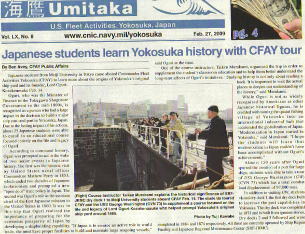 |
|||
| The newspaper "SEAHAWK" Top page Photo explanation (left)�@�@ Course instructor Taiken Murakami explains the historical importance of the SRF-JRMC Drydock 1 to Meiji University students who toured the CFAY on February 14. The students took a tour of CFAY and the USS George Washington (CVN 73) to deepen their understanding of the course, which focused on the life and legacy of Kozukenosuke Oguri. Kozukenosuke Oguri was a major force in the construction of Yokosuka's first shipyard around 1865. (Photo: Yuji Kawabe) |
||||
�@�u���̍u�t�̈�l�ł��鑺������́A�����ł̎��Ƃ�₢�A���I���n�߂����Ƃ������ɘj���ĉe�����Ă��邱�Ƃ��w�����������悭�����ł���悤�ɂƂ��̃c�A�[���v�悵���B�u���j�̕��́A�{��ǂނ����łȂ����j�̌��n��K�ˁA���������������j�̗���͂����߂邱�Ƃ���ł��v�Ƒ��㎁�͌���Ă���B �@���I�͑��̓��{�j��̐l�������قǍL���A�����J�l�ɒm���Ă��Ȃ����A���{��̂ЂȂт��������A���{�̃O���[�o�����i�ߑ㉻�j�ɔ��Ԃ����������ۓI�ȎY�Ƃ̒����ɕς����Ƃ������т�����B�u���{�̋ߑ㉻�͉��{�ꂩ��n�܂����̂ł��B���I�������������d�����Ȃ���A���{�̋ߑ㉻�͒B������Ȃ������Ƃ������Ƃ��A��u�������͊w��ł����ł��傤�v�Ƒ��㎁�͌�����B �@���I����^��p�̍`�̌��݂𑣂��Ă���قڂP�T�O�N��ɁA�w�������͔r���ʂX�V�O�O�O�g���̌��q�͋��W���[�W�E���V���g�������w���邱�Ƃ��ł����B�W���[�W�E���V���g���̏�D�ɉ����āA�w�������͉��{��̍`�p�ݔ������邽�߂ɍ��ꂽ�h���C�E�h�b�N�P�������w�����B�h���C�h�b�N�͂P�W�V�P�N�Ɋ������A�I���ȐΑ���ŏo���Ă���B�����ăh���C�h�b�N�Q���ƂR�������ꂼ��P�W�W�S�N�ƂP�W�V�S�N�Ɋ��������B���݂ł͎O�̃h�b�N�S�Ă����{��͑D�C�����E���{�n�搮���Z���^�[�i�r�q�e-JRMC)�Ƃ��ĉғ����Ă���B�i���c��q��j |
||||
| Taiken Murakami, one of the instructors of the course, planned this tour
to supplement the classroom lessons and help the students better understand
the long-lasting impact of what Oguri started. Murakami said, "When
studying history, it is important to not only read books but also visit
historical sites to improve our own understanding of history. Oguri is not as widely known to Americans as other figures in Japanese history, but he is credited with transforming the humble fishing village of Yokosuka into an international industrial hub that spurred Japan's globalization (modernization). "Japan's modernization began in Yokosuka. The students will learn that Japan's modernization would not have been possible without the work that Oguri did," Murakami said. Almost 150 years after Oguri urged the construction of a port dedicated to large ships, the students were able to visit the George Washington, a nuclear-powered aircraft carrier with a displacement of 97,000 tons. In addition to boarding the George Washington, the students also toured Dry Dock #1, which was built to augment Yokosuka's port facilities. The dry dock was completed in 1871 and is made of skillfully crafted stone. Dry Docks No. 2 and No. 3 were subsequently completed in 1884 and 1874, respectively. All three docks are now in operation as the Yokosuka Ship Repair Factory - Japan Regional Maintenance Center (SRF-JRMC). (Translation by Ayako Takada) |
||||
| �@�@�@�@�@�֘A�y�[�W�@�@�@ ���x��������͉��{�ꑢ�D���̖��F�Q�n�ɓ`��鉡�{���DNA�ӂ��� �����{�ꑢ�D���̎؊����F��菑�̓ǂ݈Ⴂ�ŔG��� �����I�̔G��߁E�l���E�ڈ�S�ۂɂ����F����������̒��̍������� ����y�������ƣ�̉��{�ꑢ�D���̃y�[�W �������K�̃y�[�W�F����Ɠ���ł����A���{��ō��ꂽ�����K ���X�ѕی�琬�̒��F���D�ɂ͑��ʂ̖؍ނ��K�v������E�E�E �����{�ꖾ�ꗗ�}��ǂ��F�ߑ�H�Ƃ̐�[�ݔ������낦�A�����̌����q�łɂ������ �����܂̉��{�ꑢ�D���u���Đe�P�x�[�X���j�c�A�[�v�i�����N�j �����C�M�́u�C�R�T�O�O�N���v���F�u�C�M���L�v�̐M�ߐ���炮 �����������̎ӎ��F���{�C�C��̏����͏��I����̂������E�E�E �������̍\�����v�F�l�W�����y�Y�ɂ������I���� �����{��̌ւ�I���{�ꐻ�S���i���D���j�i�����N�j ���t�����\���E���I���X�E���F���j�[�F���{����������i�����N�j ���u���F���j�[�E���I�Ձv���T�i�����N�j �����I����̌��t�u���{�̉^���A���{�̉^���v |
�@�@Related Pages ��Tomioka Silk Mill is the sister of Yokosuka Shipyard: Two pieces of Yokosuka's DNA handed�@down in Gunma �� The theory that the Yokosuka ironworks were built with borrowed money : It was wrongly alleged by a writer who misread the historical materials.�� Falsely accued Oguri - he used Shikoku and Ezo as collateral�FA baseless theory in the turmoil of the late Edo period�� Yokosuka shipyard, "House for sale with a storehouse" �� The bricks of Yokosuka Shipyard: Bricks made in Yokosuka, which we could finally get. �� Advocacy of forest protection and cultivation�F Shipbuilding requires a lot of wood...�� Chief Engineer Francois-Leonce Verney�F Yokosuka City Website (link)�� Reading the "Detailed Drwing of Yokosuka""�F Yokosuka with advanced facilities of modern industry was crowded with visitors. Read from the drawing that Yokosuka was the place of the Industrial Revolution in Japan. �� Yokosuka Shipyard "Japan-U.S. Friendship Base History Tour" (link) �� Kaishu Katsu's "500 Year Navy Theory"�F The authenticity of "Kaishu's Diary" wavers. �� General Togo's Acknowledgement�F Victory in the Battle of the Sea of Japan was thanks to Mr. Oguri... �� Structural reforms at the end of the Edo period�FKozukenosuke Oguri brought a screw as a souvenir. �� Pride of Yokosuka! Yokosuka Ironworks (Shipyard) (link) �� Francois-Leonce Verny: Japan Dredging and Reclamation Engineering Association (link) �� Ceremony of "Verny Oguri Festival" (link) �� "The fate of the Shogunate, the fate of Japan" by Kozukenosuke Oguri �� Exploring Yokosuka (link) |
|---|